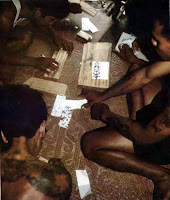
 A Glimpse of Mt.Kinabalu
A Glimpse of Mt.Kinabalu
After recovering from a good meal, there quite a few activities to be done here. Remember i mention about the uses of bamboo just now, we'll teach you how to make them and a few more. Ever fancy blowing a traditional blowpipe, that's here too. You need to be careful walking around the outer campsite area, the well camouflage traps is set up to catch anything from rats to Wild Boar, you'll just have to see it to believe it, its ingenious how these traps was made and set ups, everything they need, they just use from the forest.

 After dinner we did a night walk around the camp grounds, we saw quite a few Frogs, insects and illumines mushroom. Here are some photos. But what interest me the most is......
After dinner we did a night walk around the camp grounds, we saw quite a few Frogs, insects and illumines mushroom. Here are some photos. But what interest me the most is......This Little guy, I've seen some small frogs in my time but this one is ridiculously tiny. We found it by accident, well actually my friend found it. His name is Martin Boakes, was with me visiting Miki Survival Camp. While looking for insects and such he notice this odd looking piece of leaves stuck to another bigger greener leaf, and said "whats that, oh its a piece of leave?" i replied "yeah a piece of leave!! Oh......hang on........ it a FROG!!!" The tiniest, littlest frog i ever did see..here it is..
After that interesting discovery, we chatted away the night in front of a burning campfire and had ourselves a good bottle of rice wine.















